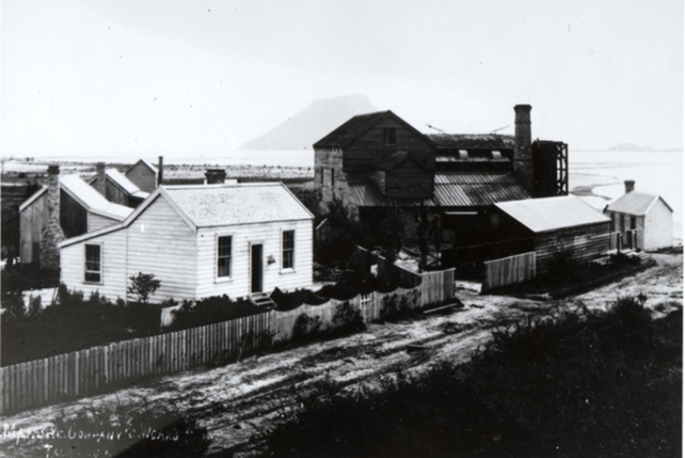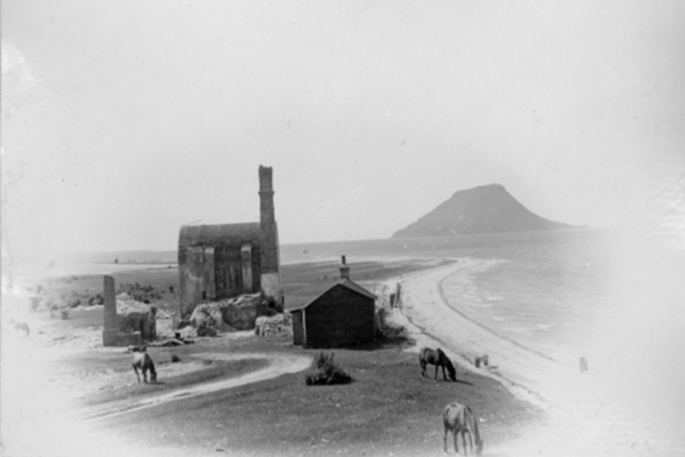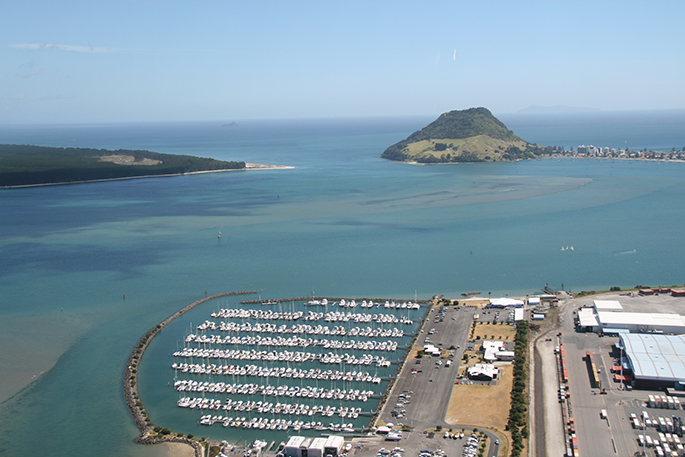“Once you come here, you can never leave” grinned the old codger from Edwards Engineering. He leaned against the main gate to his workplace and watched as a small group of young boat builders struggled their machinery off a couple of ramshackle trailers hitched onto a rusty Toyota and Mr. Hutcheson’s “landcrab”, which was some sort of Morris car of dubious capabilities. The time had come to re-locate the workshop from the back of Greerton, much closer to the water.
Sulphur Point Marina today It was about 1988. Sulphur Point beckoned some more marine activity once again, as it had done for many generations. Being located by the sea is appropriate for most marine tradespeople, and the 1980s saw a fresh influx onto Sulphur Point, of boat builders, riggers, stainless fabricators, marine engineers, sail/canvasmakers, timber merchants, electricians, chandlers, fishermen, slipway operators, painters, mechanics, upholsterers, and associated clubs, lunch-bars and restaurants. The “Spit” had recently been greatly increased in acreage, as tailings from the new Cutter Channel, and general channel dredgings were pumped between two northward-jutting rock walls over a period of a couple of years, to form a large reclamation. The Spit was changing, but it had seen much over the preceding centuries..... A short pre-history Legend records no visit to Tauranga harbour by Kupe {925ad}, and verbal records do not mention human existence on Aotearoa in his extensive coastal exploration. A period of time elapsed, and habitation of Aotearoa is apparent from 1280ad. Archeological surveys show no activity in this region before 1350 AD. Perhaps the drawn-out Kaharoa eruptions of 1305 - 1314 rendered our locality rather inhabitable. The massive ash layer, de-forestation and resultant acidity flowing into the harbour from the many tributaries, would have altered the availability of ready food resources for a couple of decades. Toi-te-huatahi (Toi) and his crew were possibly the first humans to set foot on The Spit, not long after Kaharoa had settled down. They noted the attractive geography in the backdrop, but this was not yet a sustainable region to feed and nurture his whanau and crew. It needed re-growth, and replenishment. Toi moved on to settle in Whakatane. Ironically, the ash layer eventually spurned new growth like never before. Around 1350 the voyaging Takitimu waka, and others pulled into Tauranga Harbour (Te Awanui), and the settlers were pleased to find sustainable stocks of shellfish, fish, fern-roots and abundant birds which foraged amongst the new, lush scrub. Interestingly, around the time of human habitation, the vista from Sulphur Point (Te Pari taha o Te Awanui) was much more open. The Harbour entrance was considerably wider, and Mt Maunganui was virtually an island. The harbour was more extensive and steep clay cliffs plunged into the sea where Dive Crescent is today. Once the land was again arable the prominent Headland of Sulphur point provided the necessities: Elevated habitation, very close and plentiful resources, and a sheltered anchorage for canoes. Towards the mid 15th century, some fortification was becoming necessary, as attractive real estate then, tended to require some security, just as it does today. Geological surveys indicate two significant tsunamis sweeping parts of the Bay of Plenty during the mid 15th century. Matakana Island was re-configured somewhat, but local headlands appeared to have remained largely intact. These events probably destroyed any remaining ocean-voyaging double canoes. A significant number of residents re-located to higher ground, such as the Papamoa hills. But stalwarts appeared to remain at Te Papa due to the readily available shellfish and seafood stocks, and freshwater attainable from the nearby Waikereao stream. The sulphur works in 1880’s European settlement In 1828, The (first) European schooner “Herald” reported that Tauranga natives could muster a force of several thousand fighting men. 1000 canoes were counted on the foreshore between Te Papa pa (Sulphur Point) and Otumoetai. Upon her second visit later that same year, the crew of the Herald came across a scene of utter devastation. Te Papa pa belonged to the Ngatitapu who had made a pact with the tribes of Waharoa in order to allow the Matamata natives passage to the sea. This did not err well with the Thames tribe Ngatimaru who mustered a considerable war party and sacked Te Papa pa, dispensing 2000 lives. Only 25 inhabitants of Te Papa escaped. Those killed were made into roasts or stews according to the caprice of their captors. It was some time before Te Papa was re-populated. European influx In time a military redoubt, a Mission house, and a military, and Maori graveyard took residence on this coveted soil. The newly charted approach for sailing ships to the headland required passage to the East once the entrance was negotiated. Not all vessels successfully navigated this last stretch, and an early shipwreck was a trader from Valparaiso which foundered on the shallows. Her crew of Spaniards waded ashore, and, today, a row of stones just underwater a couple of metres on the South side of G pier marks where workers uncovered some of her bones during marina construction in 1979. As settlers moved in, the spit accommodated various transient activities. Early on, a Sulphur works processed raw material barged from White Island. Various ragtag industries followed, including fish processing, slipways, boat building, sawmilling. It was a slightly unattractive place, exposed to prevailing Westerlies and Northerlies most of the time. Early photos of the area show a lack of trees or significant vegetation, as was the case with much of the Tauranga region. Centuries of burn-off, often in an effort to clear land for cropping, rendered the land largely clear of trees, and mostly covered in secondary scrub. The sulphur works in 1901 Recent times The most significant transformation was the massive Port company reclamation of the mid 1970’s. Within 3 years the Spit had increased in size tenfold. The Port Company built a pristine 600 ton capacity slipway initially to service their Tugs, but eventually they added wharfage which accommodated 40 boats, and built a tractor-driven travel-lift from a spare wharf Hopper. Work and Safety would not tolerate such a rudimentary contraption nowadays, but this device successfully lifted hundreds of vessels under 12 ton for many years onto the hardstand for maintenance. It was a hive of activity and undoubtedly Tauranga’s marine hub. Not to rest on its laurels, the Port Company then built the Sulphur Point Marina in 1980, and initially managed the land, with the foresight to include large ‘green’ areas. Wharfage was built down the Eastern side of the reclamation as per original plans, whilst leaving space for fishing and service industries to the South. Today, the Spit bears no resemblance to the windswept sandbar of a previous millennium. Well-established industry chugs away around the clock. Wharf straddle-lifts thread their way through stacks of containers 24/7, and New Zealand’s largest container cranes seldom stop for a rest. During the day, marine industry workers move like ants from workshop to marina; and back, countless times. They all know each other. Many of them have for several decades. After all, it’s like the line in the song ‘Hotel California’.... “You can check out any time you like, but you can never leave.” Very recently a group of officialdom turned a sod of sandy soil, to herald the construction of a considerable new marine precinct. Plans include wharfage haul-out facilities and re-fit premises able to cater for super-yachts, (no less). A number of local businesses have committed to space in this development, and employment opportunities in Sulphur Point will swell once again. Only this time the travel-lift will cost vast sums, and workers will no longer have to balance on rickety planks placed on 44 gallon drums as they toil in the never-ending trade of vessel re-finishing. Each day I drive past the symbolic anchor stone and the displayed stories at the bridge off-ramp on my way to ‘Hotel California” It’s my third “term” back at Sulphur Point in 40 years. Recently I took my time to read the embossed scripts which circle the anchor stone and they tell of the first humans to visit this (originally) windswept sandbar. Strangely, in several thousand trips over the bridge over the years, I have never seen another soul standing there taking the time to read these scripts. Just above this is the military graveyard of Otamataha which features very early Maori and European graves. Countless fighting men of are also buried beneath these same soils in unmarked graves. Even these guys never got to leave. Hotel California indeed.




0 Comments
Leave a Comment